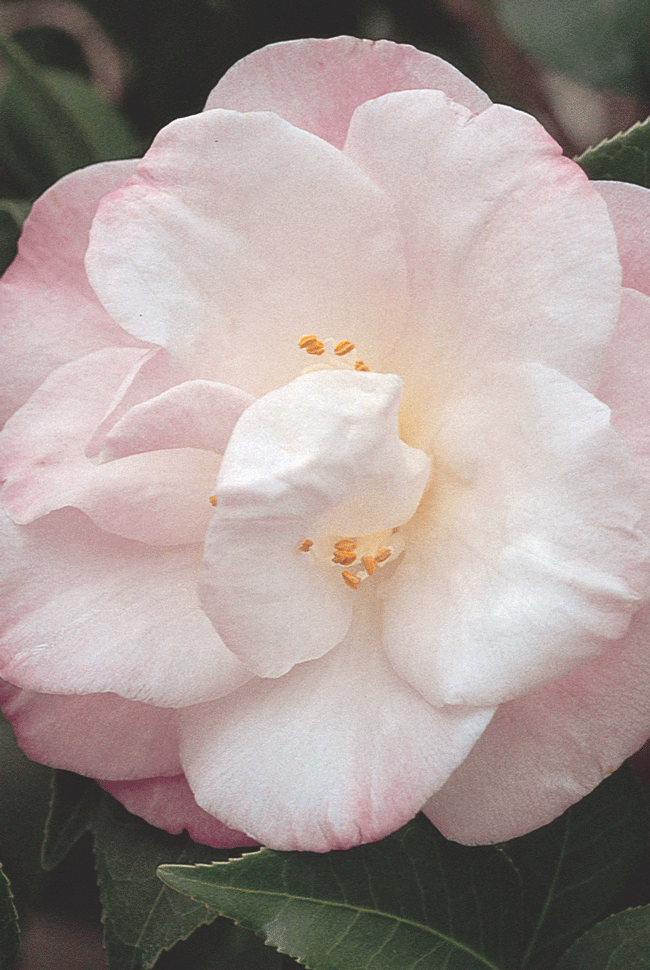
April Remembered Camellia
Camellia japonica 'April Remembered'
Care & Maintenance
Plant Code:
LW03221
Light:
Part Sun - Morning Sunlight Only
Water:
Semi-Moist
Bloom Time:
Winter Spring
Flower Color:
White
Average Size:
6-8' H x 6-8' W
Spacing:
6-8'
Cold Hardiness:
Zone 7 (10 to 0°F)
About This Plant
Flowering shrubs, prized for their outstanding show of blooms, should be a part of every landscape. Use a single specimen to brighten a shady spot or plant in mass for a burst of color. Utilize varieties with different bloom times to brighten the landscape all season long. Plant flowering shrubs in highly visible areas where they can be enjoyed. Utilize green-leafed shrubs as a background to make the flowers stand out where possible. Evergreen flowering shrubs maintain their leaves year around while deciduous varieties loose their leaves in the fall and re-leaf in the spring.
Additional Information
Protect from drying winds and hot afternoon sun. Thrives in semi-moist, well-drained acidic soil.
Uses
Color Accent, Specimen, Foundation Plantings, Hedge, Mass Planting, Container
Attributes
- Huge, cream to white blooms
- Dark, glossy foliage
- Great accent or background plant
- Thrives in rich, organic soils
How to Water
- New plants require more frequent watering than established plants. After planting check for water regularly until fully rooted and established.
- For large plants; build a soil ring around the plant to use as a water reservoir. This will assist in watering until the plant is established.
- Always water slowly and deeply making sure the root ball is completely saturated.
- Don't water at night if possible. Watering in the morning helps prevent disease.
- If new plant wilts between watering, increase the frequency of watering.
- Plants in hot, humid or sunny areas need more frequent watering than plants in cool climates.
- Plants in containers may require more frequent watering than plants in the ground. This will depend on plant variety, pot size and soil.
- Add a 2-3"" layer of organic mulch around plant to maintain and conserve soil moisture. Mulch will reduce watering frequency and speed root establishment.
How to Plant
- Prepare the area for planting by conditioning the soil. Loosen the soil and incorporate an organic soil conditioner according to directions.
- Dig a hole 2 times the width of the root ball and a depth slightly less than the height of the root ball. Allow the top surface of the root ball to rest 1/2 inch higher than the soil line.
- For container grown plants, carefully remove plant by squeezing container and slowly removing the root ball. Never pull on the plant trunk. Instead let the root ball slide out by tipping the container. If the plant is heavily rooted, loosen roots by gently pulling a few away from the root ball. This encourages stronger root growth. Set root ball in hole making sure the top of the root ball is slightly higher (1/2 inch) than ground level. Place soil mix under root ball if too low. Backfill soil mix around plant to ground level and tamp lightly removing all air pockets.
- For biodegradable pots, follow the directions on the container.
- For bare root plants, trim any broken, twisted or discolored tips. Determine the original soil line by the change in color on the plant trunk. Set the plant in the hole so the soil line is above the surrounding soil. Space the roots evenly. Backfill soil mix around and between the roots and tamp lightly removing all air.
- Water thoroughly to settle the soil around the plant. Add more soil mix around plant if necessary after watering. Apply root stimulator to encourage new root growth and fast establishment.
- If a large plant; build a soil ring around the plant, 6" beyond the edge of the hole, to use as water reservoir to assist in watering until established.
- Add a 2-3" layer of mulch around plant to conserve soil moisture and eliminate future weeds.
- For large shrubs, it may be necessary to secure the trunk by using three stakes placed at equal distances around the plant.
How to Fertilize
- Fertilize just before and during the plants active growing cycle. Fertilization should begin just prior to new growth and end three or four weeks before the first frost.
- Choose a fertilizer recommended for acid loving plants. Frequency will depend on the type of fertilizer. Liquid (water soluble) and granular quick release fertilizer require more frequent application; slow release granular types require less.
- When using granular fertilizer be sure to sprinkle fertilizer pellets away from the plant stems or trunk to prevent possible burning and always water thoroughly after application. This dissolves or releases the fertilizer into the soil. Apply water soluble fertilizer by thoroughly drenching the leaves and soil.
- Always follow fertilizer package directions.
How to Prune
- Prune as required to keep plants a desired size or shape.
- Encourage new blooms by cutting off dead or faded flowers.
- Plants with branches originating from the roots of the plant need to be selectively pruned. Prune by removing the oldest branches completely. This will allow new, more productive branches to develop and produce flowers.
- Remove damaged or dead limbs back to live wood.
- When pruning, make angled cuts just above the bud.
- Use proper tools such as shears, hand pruners, pole pruners and pruning saws. Make sure all equipment is clean and sharp.
- Fertilize after pruning to help speed new growth.
Resource Center
Product Checklist
- Planting MixPromotes strong healthy growth and more flowers
- Potting SoilReady to use mix for indoor and outdoor containers and hanging baskets
- Plant StarterHelps plants quickly establish to their new home
- Slow Release FertilizerFeeds for months with one application. Safe to use on new plantings
- Organic MulchPrevents weeds for months, saves water and beautifies
- Planting ToolsShovels, trowels, cultivators and other tools to make planting easy
- Pre-emergent Weed ControlApply to ground after planting to prevent new weeds from sprouting
- Soaker HoseEasy to use, conserves water, and reduces chance of leaf diseases
- ContainersChoose from light weight resin, clay or ceramic for patio or porch
- Landscape EdgingKeeps beds defined, easy to maintain, and free of lawn grass
- Hedge or Pruning ShearsRegular pruning keeps shrubs full and promotes more flowers


 We could not acquire a location at this time.
We could not acquire a location at this time.


